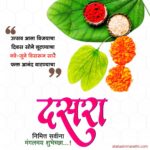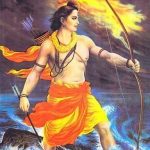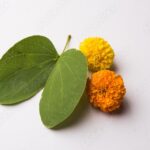
In Marathi, there is one saying
"दसरा सण मोठा,
नाही आनंदा तोटा"
This means that Dasara is such a festival which is full of joy, happiness and commemorates the triumph of good over evil. We celebrate the nine days beginning from Ashvin Shuddha Pratipada as "Navaratri" and the tenth day is celebrated as "Dasara / Vijaya Dashami". In 2020 अश्विन शुद्ध प्रतिपदा falls on Saturday October 17th.
During this vowed religious observance, a pot is installed (घटस्थापना) at a sanctified place at home. A lamp is kept lit in the pot for nine days. The pot symbolizes the universe. The uninterrupted lit lamp is the medium through which we worship the effulgent Adishakti, i.e. Shree Durgadevi. During Navratri, the principle of Shree Durgadevi is more active in the atmosphere.
There are a lot of anectotes relevant to [!img] Navatri and Dasara. They say the demon "Mahishasur" started terrorising Swarga Loka (Heaven) and Prithvi Loka (Earth) after Brahma granted him a boon that no man or god would be able to conquer him. . He invaded Swarga Loka and defeated the king of gods Indra and took control of Swarga Loka. He drove all the Devas (Gods) out of heaven. Eventually, they created his nemesis in the form of a young woman, Durga, also known as Shakti or Parvati. She combined the powers of all the gods to fight Mahishasura. The goddess then attacked Mahishasura's empire, and after nine days of fighting, during which Mahishasura's army was decimated, he was finally killed on the tenth day of the waxing moon by her incarnation Kali (which appeared from her forehead). Durga was henceforth called Mahishasuramardini, the killer of Mahishasura.
Navaratri is celebrated to worship nine forms of Durga Maa with fervour and devotion. Navaratri is celebrated in different ways throughout India. In Gujrat, they try to please the Goddess by a special dance called "Ras-Garba". In Bengal the festival of Durga Puja is celebrated. In Kerala, the "Onam" festival represents Navaratri and Dasara. They believe that Bali raja was so kind, that even if he was pushed to Patal lok (The nether world), he would come to the earth to see if everybody is doing good on Dasara.
In Mysore (an ancient city in the south Indian state of Karnataka, around 125 Km from Bangalore) there is a tradition of holding a grand procession through the streets of the city with the idol of the goddess Chamundeshwari riding in a golden Ambaari (elephant-seat).

In North India, Dasara is the day when Prabhu Shree Ram killed the demon Ravan. So the nine days are dedicated to Ramlila i.e chanting Rama Bhajans and on the tenth day statue of Ravan is burnt. The burning of the effigies is symbolic to cleanse society of all evil by burning it.
There is a very interesting story about why we give the leaves of "Shami" to each other on Dasara. They say that when Pandavas went to "Adnyatwas" they hid their weapons on Shami tree. And when the Adnyatwas was about to end the Kauravas took away the cows of Raja Virat under whose shelter Pandavas lived. So to save the cows Arjun got his weapons back from the "Shami" tree and that was "Dasara"
There is another very interesting story about the "आपट्याची पानं" (Leaves of Shami tree) .

It goes like this:
Once there was a boy names Koutsa, who wanted to offer Gurudakshina to his Guru. his guru after Koutsa insisted, asked for 14 crores (140 Million) of gold coins. now Koutsa didnt have as many coins so he went to King Raghuraja. To fulfill his demand, Raghuraja decided to attack Indra and get the money. But when Indra came to know that Raghuraja was going to fight him he was scared, later he knew the main reason of the fight. So he requested Kuber (Treasurer of God) to load the "Shami" tree with gold coins. Now Koutsa offered all the coins to his guru but Guru accepted only 14 crores of coins nad asked Koutsa to put the remaining back on the tree. Later on those coins were distributed among people, and since that day was "Dasara" we give each other the "Shami" leaves symbolically.
Indians give a lot of importance to start any project, journey, activity or make a purchase at an auspicious time. According to Hindu Mythology there three and a half very auspicious days (साडे तीन मुहूर्तांपैकी एक) in an year on which you can start any project or make any purchase without waiting for an auspicious moment. Dasara is one of those days. Therefore many people buy jewellery on the occasion of Dasara. The 9th day is "Ayudha Pooja" when everyone gives their tools of the trade -- pens, machinery, books, automobiles, school work, computers etc. a rest and ritually worships them. They start afresh from the next day, the 10th day which is considered as 'Vijaya Dashami'. Many teachers/Schools in south India start teaching Kindergarten children from that day onwards. Students also pay homage to their respective teachers as they are considered the third god (माता, पिता, गुरू आणि दैव - Mother, Father, Teacher & God).

